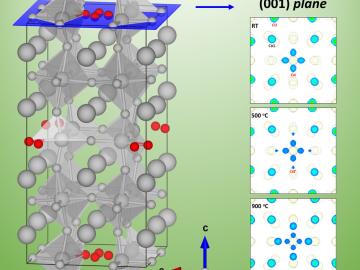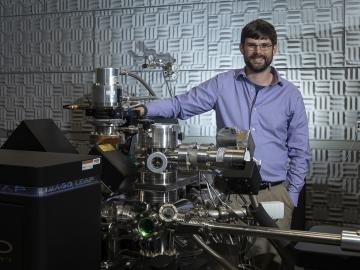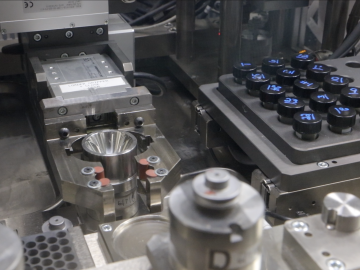
Filter News
Area of Research
- (-) Isotopes (4)
- (-) Materials (76)
- (-) Neutron Science (29)
- (-) Nuclear Science and Technology (5)
- Advanced Manufacturing (6)
- Biology and Environment (86)
- Biology and Soft Matter (1)
- Computational Biology (1)
- Computational Engineering (2)
- Computer Science (7)
- Energy Science (123)
- Energy Sciences (1)
- Fusion and Fission (6)
- Fusion Energy (2)
- Materials for Computing (13)
- Mathematics (1)
- National Security (17)
- Quantum information Science (2)
- Supercomputing (63)
- Transportation Systems (2)
News Type
News Topics
- (-) Artificial Intelligence (7)
- (-) Big Data (2)
- (-) Energy Storage (17)
- (-) Environment (9)
- (-) Materials Science (46)
- (-) Microscopy (14)
- (-) Nanotechnology (20)
- (-) Polymers (12)
- (-) Security (1)
- (-) Space Exploration (9)
- (-) Transportation (13)
- 3-D Printing/Advanced Manufacturing (13)
- Advanced Reactors (9)
- Bioenergy (7)
- Biology (3)
- Biomedical (18)
- Buildings (2)
- Chemical Sciences (14)
- Clean Water (4)
- Composites (6)
- Computer Science (14)
- Coronavirus (7)
- Critical Materials (5)
- Cybersecurity (1)
- Exascale Computing (1)
- Fossil Energy (1)
- Fusion (12)
- Grid (2)
- High-Performance Computing (2)
- Hydropower (1)
- Irradiation (1)
- Isotopes (26)
- Machine Learning (4)
- Materials (37)
- Mathematics (1)
- Molten Salt (5)
- National Security (2)
- Neutron Science (84)
- Nuclear Energy (39)
- Partnerships (3)
- Physics (15)
- Quantum Computing (3)
- Quantum Science (3)
- Summit (2)
Media Contacts

Scientists have tested a novel heat-shielding graphite foam, originally created at Oak Ridge National Laboratory, at Germany’s Wendelstein 7-X stellarator with promising results for use in plasma-facing components of fusion reactors.
Scientists at the Department of Energy’s Oak Ridge National Laboratory (ORNL) have developed a process that could remove CO2 from coal-burning power plant emissions in a way that is similar to how soda lime works in scuba diving rebreathers. Their research, published January 31 in...

A University of South Carolina research team is investigating the oxygen reduction performance of energy conversion materials called perovskites by using neutron diffraction at Oak Ridge National Laboratory’s Spallation Neutron Source.

Jon Poplawsky, a materials scientist at the Department of Energy’s Oak Ridge National Laboratory, develops and links advanced characterization techniques that improve our ability to see and understand atomic-scale features of diverse materials

By automating the production of neptunium oxide-aluminum pellets, Oak Ridge National Laboratory scientists have eliminated a key bottleneck when producing plutonium-238 used by NASA to fuel deep space exploration.

Oak Ridge National Laboratory scientists studying fuel cells as a potential alternative to internal combustion engines used sophisticated electron microscopy to investigate the benefits of replacing high-cost platinum with a lower cost, carbon-nitrogen-manganese-based catalyst.
![2018-P07635 BL-6 user - Univ of Guelph-6004R_sm[2].jpg 2018-P07635 BL-6 user - Univ of Guelph-6004R_sm[2].jpg](/sites/default/files/styles/list_page_thumbnail/public/2018-P07635%20BL-6%20user%20-%20Univ%20of%20Guelph-6004R_sm%5B2%5D.jpg?itok=hUSyvkP0)
A team of scientists, led by University of Guelph professor John Dutcher, are using neutrons at ORNL’s Spallation Neutron Source to unlock the secrets of natural nanoparticles that could be used to improve medicines.

Carbon fiber composites—lightweight and strong—are great structural materials for automobiles, aircraft and other transportation vehicles. They consist of a polymer matrix, such as epoxy, into which reinforcing carbon fibers have been embedded. Because of differences in the mecha...

An Oak Ridge National Laboratory-led team used a scanning transmission electron microscope to selectively position single atoms below a crystal’s surface for the first time.

Sergei Kalinin of the Department of Energy’s Oak Ridge National Laboratory knows that seeing something is not the same as understanding it. As director of ORNL’s Institute for Functional Imaging of Materials, he convenes experts in microscopy and computing to gain scientific insigh...


